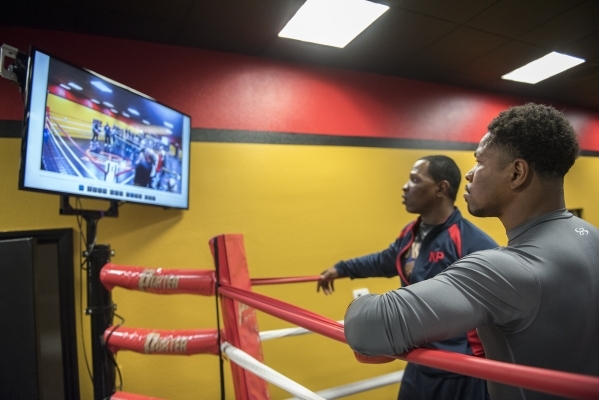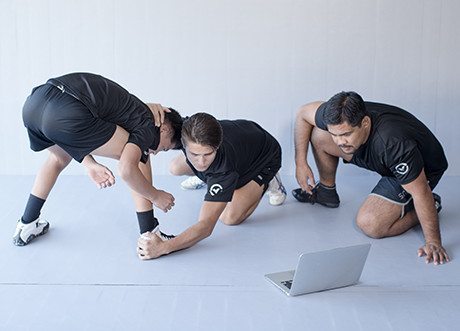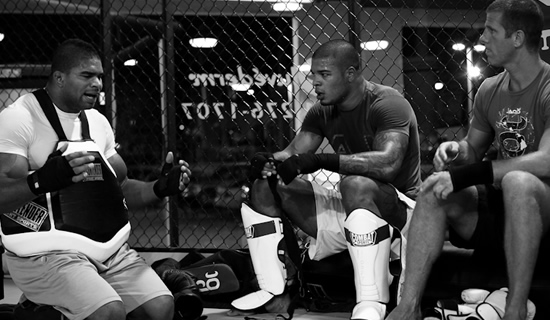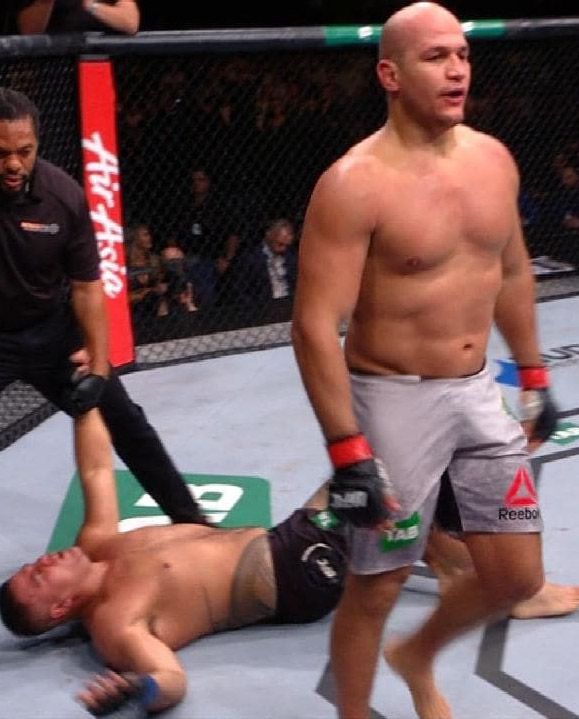In part one of this series, I discussed what defines outside consultants and analysts, as well as the benefit of using them in the MMA landscape; in part two I will discuss the roadblocks that keep camps and fighters from actively using analysts and consultants in their game planning, preparation, and training for scheduled or short-notice opponents.
In more traditional sports there is a long and hallowed history, with countless numbers of coaches, coaching styles, fighters, fighting styles, and years of growth, refinement, experimentation and adjustment that organically happens as a sport grows. This isn’t limited to just the professional ranks; this happens at every level, from Pop Warner to the Pros. That means that a large majority of people have competed at some level in basketball, football, baseball, soccer, and tennis; firsthand experience in these sports is a huge advantage that most people in and around mixed martial arts don’t have, since it has only been around for about 20 to 25 years. What this means is that it’s easier to find consultants who have taken part in these traditional sports — they understand the strategies, the techniques, the coaching styles, and the training necessary to take part in these sports.
Even people who haven’t competed have countless hours or years of experience watching these sports at every level possible. This is yet another advantage the traditional sports have over combat sports. “Why is that an advantage,” you say? Easy, if I am a coach or a fighter and I am seeking outside advice or direction, I have to trust the source I am receiving it from. I have to feel that whomever I’m asking for help understands the concepts and strategies that shape, direct and drive the sport, whether it’s through the firsthand experience of playing over a period of time, the secondhand experience of being an invested observer or person engaged in coaching, or the third-hand experience of researching the sport and its history through film watch or book study. You know that the person you are talking to has a lot of resources to develop a base of knowledge and learn how to apply it in a manner that can benefit the athletes/coaches in traditional sports. That doesn’t exist in MMA. The history and the outlets aren’t as easily accessible, nor do enough people have a base of knowledge in individual combat sports, much less mixed martial arts as a whole. And that will make a large amount of camps and fighters hesitate when it comes to bringing in outsiders to have a say in what a fighter will do and how the camp goes about making that happen. As Tom Herman said in his press conference, “We need guys we can trust in character and in knowledge.” Unfortunately, in mixed martial arts that trust doesn’t really exist.
There is another reason that consultants and analysts aren’t often used in mixed martial arts, and it’s a reason we hear in many articles, pre- and post-fight interviews, and in many discussions had by fans and media members: MONEY! To break down footage to the point that a consultant or analyst could provide information that could make a difference, you would have to watch a lot of film of fighting and sparring. And not just that; you would have to carefully watch that footage, repeatedly and carefully, in order to find holes, tendencies, and habits. It takes a lot of effort, time, and attention to detail to find patterns, key techniques, or areas of limitations on a technical and strategic level. What I am saying is it’s almost a full time job.
 In other sports, it actually is a full time job, and consultants and analysts have many more resources to utilize in researching an opponent. These things are still scarce in the mixed martial arts landscape. That means a consultant or analyst in MMA has to work that much harder to contribute the same amount of quality information that an analyst or consultant from a traditional sport would. This requires an investment of time and energy that demands compensation — the same as a striking coach, grappling coach, strength & conditioning coach, or head coach would require. Unfortunately, in mixed martial arts, that sort of financial support doesn’t exist. Scott Harris did a masterful job of explaining the plight of the mixed martial artist and the sport as a result of the financial instability in “the fastest growing sport in the world” in a recent Bleacher Report piece.
In other sports, it actually is a full time job, and consultants and analysts have many more resources to utilize in researching an opponent. These things are still scarce in the mixed martial arts landscape. That means a consultant or analyst in MMA has to work that much harder to contribute the same amount of quality information that an analyst or consultant from a traditional sport would. This requires an investment of time and energy that demands compensation — the same as a striking coach, grappling coach, strength & conditioning coach, or head coach would require. Unfortunately, in mixed martial arts, that sort of financial support doesn’t exist. Scott Harris did a masterful job of explaining the plight of the mixed martial artist and the sport as a result of the financial instability in “the fastest growing sport in the world” in a recent Bleacher Report piece.
 Consultants and analysts provide valuable tools, tools that have been proven useful in every other major, and minor, sport in the world. However, in mixed martial arts their value is still in question. This is due in large part to the small sample size we have as it pertains to the strategies, techniques, and philosophies that drive the sport. Many coaches won’t feel confident in putting the reputations of their camps or the fates of their fighters in the hands of a person whose knowledge they question.
Consultants and analysts provide valuable tools, tools that have been proven useful in every other major, and minor, sport in the world. However, in mixed martial arts their value is still in question. This is due in large part to the small sample size we have as it pertains to the strategies, techniques, and philosophies that drive the sport. Many coaches won’t feel confident in putting the reputations of their camps or the fates of their fighters in the hands of a person whose knowledge they question.
But the most obvious reason for the lack of use of consultants and analysts is money. There isn’t enough money in it for people who have the skills, dedication, and knowledge to do it, and on the opposite end, the fighters don’t make enough money to absorb the cost that using a consultant or analyst would bring. That hurts mixed martial arts as a whole. Half of the reason all the other traditional sports have gotten so big and advanced so far is the commitment from those financially invested in their sports. They look for each and every advantage they can to help their program, franchise, or individual athlete. That isn’t being done in MMA, and as a result, coaching, fighters, fights, and fight cards are suffering because of inconsistent performances that result from poor game plans and limited preparation.
Limited preparation and poor game planning are things that would get you fired, if not blackballed, at the highest levels of each and every other major sport, but they are rampant in mixed martial arts, even at the highest levels. If MMA really wants to compete with the quality and consistency presented by the national and collegiate-level sports organizations, its entities are going to have to make it a point to place emphasis on the presence of analysts and consultants. More importantly, they have to be willing to make a financial commitment. In my opinion, it’s one of the first steps to the improvement of the long term viability of the fighters and the organizations they compete in.






